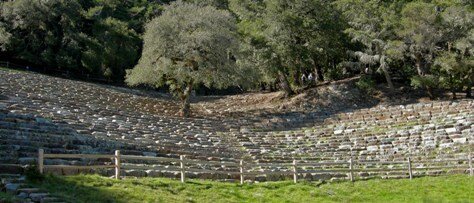By Larry Clinton, Sausalito Historical Society
Last week we told the story of the early days of the Mountain Play and lamented the closing of its 2020 season. But over its 107-year history, the Mountain Play has overcome a number of challenges along the way. The following report was compiled from a Facebook post by the Marin History Museum, from a recent promotional supplement published by the Mountain Play Association and other sources:
PHOTO FROM MOUNT TAMPALPAIS STATE PARK BY MARC HOLMES
Next year, hopefully, the banks of the Cushing Amphitheater will be full of happy playgoers
The Mountain Play Association adopted resolutions in November, 1915 which established the annual production as a permanent institution in the life and development of Marin County.
Early in the 20th century, Mountain Plays attracted thousands of patrons who hiked or took the gravity train, “the crookedest railroad in the world”, up the mountain to see traditional plays like Abraham and Isaac and Peer Gynt. The April 17, 1915 Mill Valley Record offered this advice: “The Mill Valley and Mt. Tamalpais train is taken to West Point and from there the walk is made over a practically level trail in a half hour. The 10:45 Sausalito Ferry will enable one to reach the Mountain Theatre by one o’clock, allowing an hour for lunch. The 1 1:45 will bring one to the Theatre in time for the play. Luncheon should be taken by all as there are not adequate facilities for dining. Plans should be made to spend the day on the mountain as there are abundant spots for picnicking and plenty of pure water.”
In 1924, Marin County was under quarantine due to an epidemic of Hoof-and- Mouth disease that resulted in widespread panic across the US. By May 1924, the quarantine was lifted on Marin County — too late for the Mountain Play to resume, but a relief for the overall community.
In 1929, beloved Mountain Play director Garnet Holme had a tragic fall coming down a steep trail from his Larkspur home and died three days later. There was discussion to postpone the play until the next year to honor Mr. Holme, but it was decided that he would have wanted the play to go on and it was dedicated to his memory
By the early 1930s, the quaint trains stopped running up and down the mountain due to decreased patronage because of the Depression. During 1942-1945, the U.S. Army took over the mountain and no plays were presented.
The Mountain Play Association held the deed to the property until 1936 when it was donated to California to complete the Mount Tamalpais State Park. The Civilian Conservation Corps (CCC) began work to quarry and set ‘rock terraces’ for the 3,750-seat stone amphitheater that same year.
In 1977, Marilyn Smith took over as executive producer and the Mountain Play focused Broadway-style musicals resulting in a financial revival and increased attendance.
In 2013, The Mountain Play celebrated its 100th anniversary with a production of The Sound of Music. Recently retired Executive Producer Sara Pearson accredits the Mountain Play’s longevity to its uniqueness: “It’s the combination of the natural world, that beautiful historical amphitheater and the wonder of seeing live theater outside. Those three elements make the mountain play unlike any other experience.”
Although this is a history column, now’s the time to look forward, not back. As the Mountain Play supplement recently put it: “Humans have been gathering together for thousands of years to enjoy theatre for a reason. We look forward to the Mount Tamalpais Greek-style amphitheatre being filled in the spring of 2021 with all of us regaining the opportunity to experience live theatre together — our magically great outdoor theatre adventure
Hopefully Hello Dolly can be performed next year. In the meantime, if you’d like to support the Mountain Play during this hiatus, donations can be made at https://tickets.mountainplay.org/TheatreManager/1/login&donation=0.

